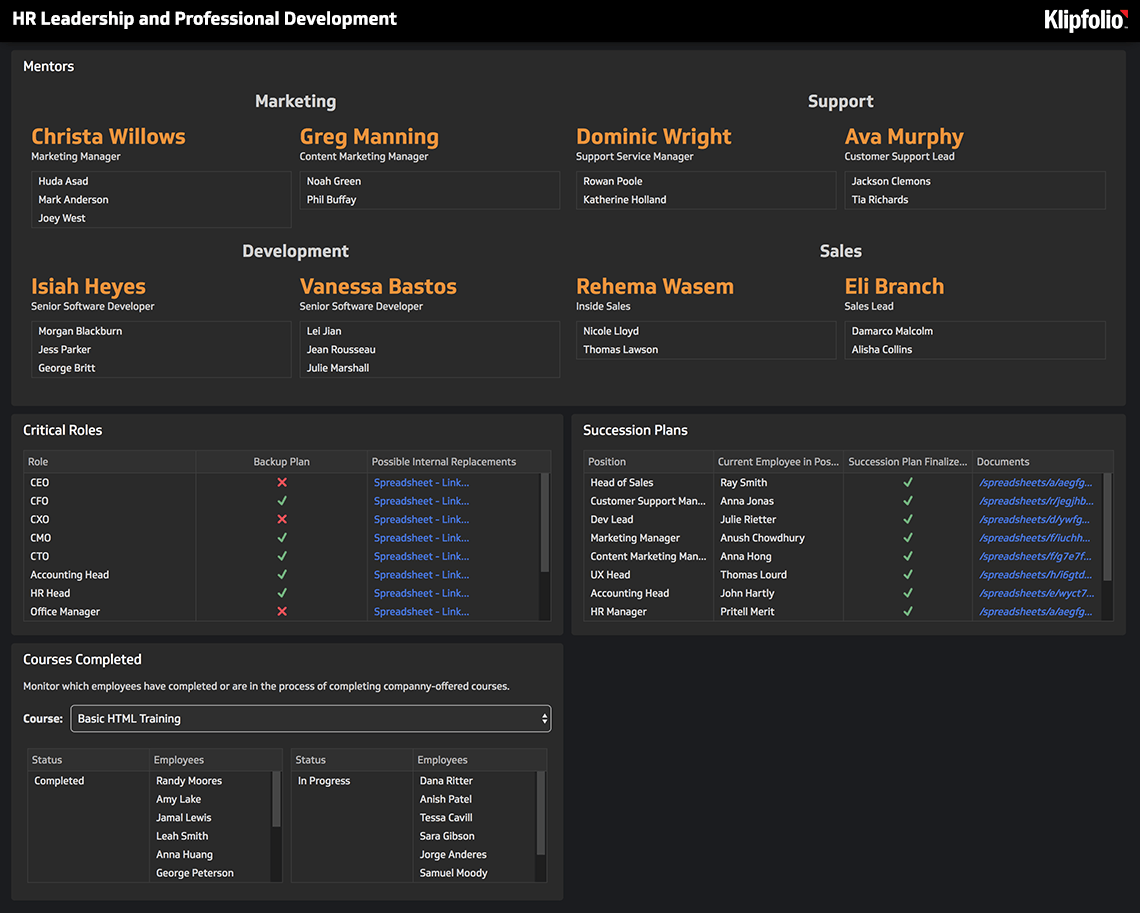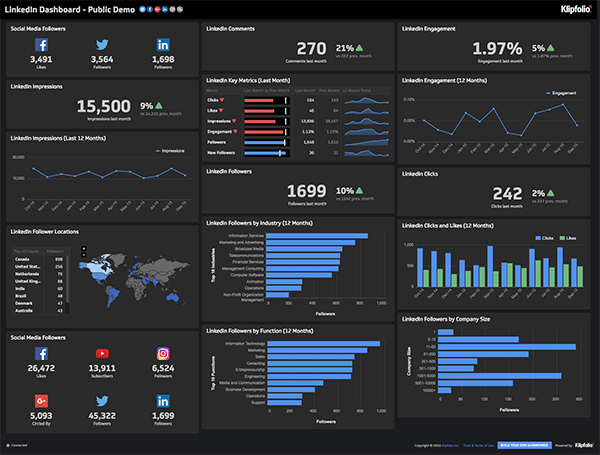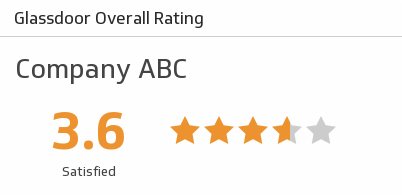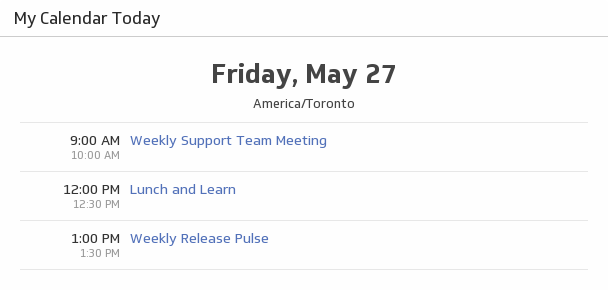- Department Solutions
- Klipfolio for HR
The control you want, the data you need.
All your HR metrics and KPIs in one dashboard reporting tool.
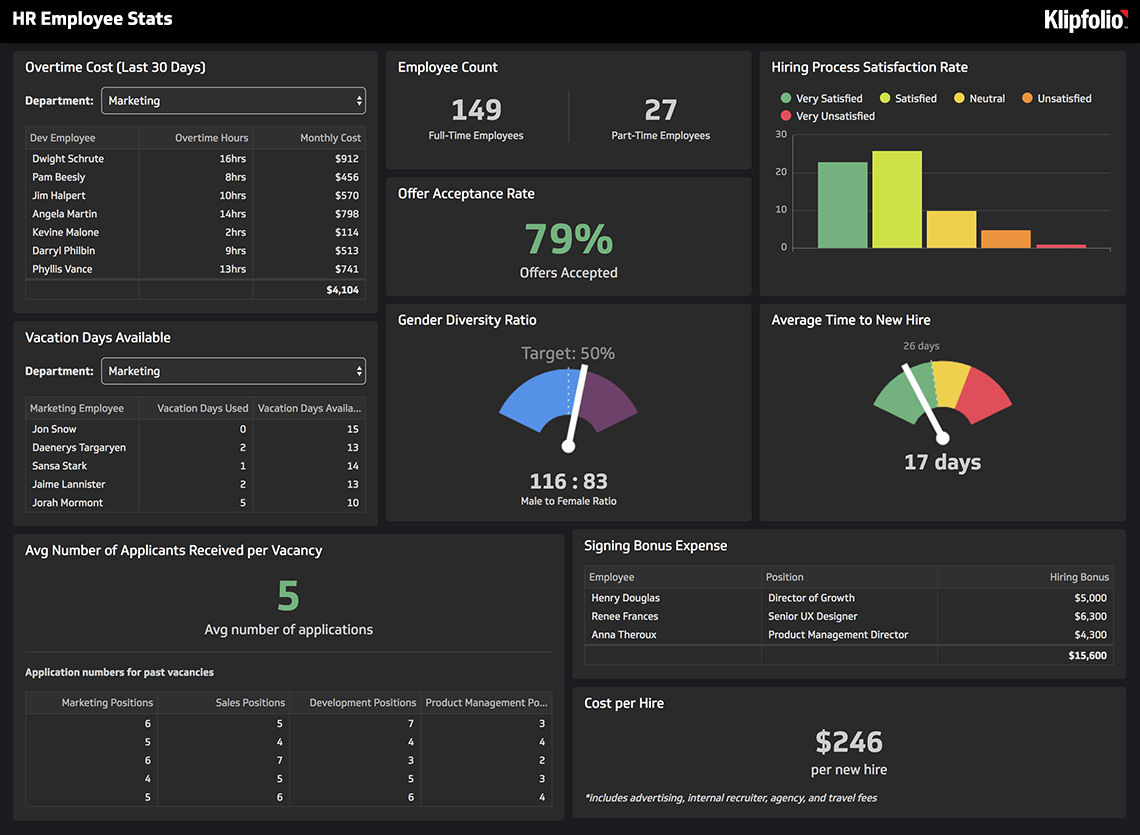
“The creators of Klipfolio are true masters of visualization, displaying real-time data in clear beautiful charts, graphs, and diagrams.”

Rodrigo Rojas
General Manager at TimeHunter
HR reporting software and analytics for talent management
Data-driven human performance management for business growth
Bring your HR data to the executive table
Let Klipfolio help you be the strategic HR professional you were always meant to be. Showcase your HR analytics data story to share your teams impact on the organization.
Drive your HR analytics with customizable dashboards and reports
Ensure your team leverages reports to make strategic and proactive decisions that positively affect your performance goals. It will become the difference between managing people and elevating them to their potential.
Build and schedule reports for all the different departments you support
Human resource management is the heart of every organization and drives the success of every team. Create the custom HR reports that every team needs.
Human resource dashboard examples
Curious to see what you can track in Klipfolio? Here are just a few examples of the HR dashboards you can build. View the live dashboard examples to get a better look.
HR Leadership and Performance Development Dashboard
- Get a real-time, interactive view of your department structure
- Track mentors for each department of your organization
- Track roles, succession plans, and professional development
LinkedIn Dashboard
- Build a LinkedIn dashboard to track your company's follower growth
- Track the number of clicks your LinkedIn page has generated
- Keep an eye on how engaging your company page and posts are
Metrics for Human Resources
Want to motivate your team and stay up to date on your data, but not sure which metrics to start with? Not to worry, we've compiled a list of the top, most common HR KPIs (key performance indicators) our users have built using Klipfolio. If you are looking for more, check out our KPI Library:
- Ethnic Diversity Ratio: Track the diversity of your company’s workforce
- Gender Ratio: Measure the ratio of male to female employees in your company
- Span of Control: Monitor the number of subordinates working under a manager
- Headcount: Track the size of your company or department
- Applications Received per Vacancy: Track the popularity of your job vacancy postings
- Signing Bonus Expense: Measure the average size of the signing bonus for all new hires
- Cost per Hire: Measure how much it costs for a single hire
- Turnover Rate: Analyze the effectiveness of your employee retention efforts
- Recruiter to Open Requisitions Ratio: Measure the ratio of recruiters to open job positions waiting to be filled
- Job Offer Acceptance Rate: Measure the rate at which job offers are accepted by prospective employees
- Open Job Requisitions: Monitor the number of open positions within your company
- Training Costs: Measure and analyze the investments put forward in your employees
- Overtime Hours: Monitor the total number of overtime hours employees are working
- Employee Engagement: Track how invested your employees are in the company
- Employee Productivity: Measure the overall effectiveness and productivity of your employees
- Part-Time Employees: Monitor the number of part-time workers and students are in your employ over time
- Revenue per Employee Ratio: Measure the Revenue generated per full-time employee working for the company.

How to track your human resource metrics with Klipfolio
Klipfolio allows you to pull in data from all of the different HR services you use to track your performance—and display precisely what you need in a single interactive dashboard. What does this mean for you? No more manual monthly reports or Excel sheets with multiple versions. And you can get started with just a few clicks.
Pre-built Metrics
Here are a few pre-built HR metrics.
Click each icon to see what's possible.
Glassdoor
Connecting your Glassdoor account with Klipfolio gives you instant access to your company's ratings and reviews. You can also combine your Glassdoor data with data from other key services. With Klipfolio you can track metrics like:
- ✔ Overall rating
- ✔ Culture ratings
- ✔ Value ratings
- ✔ Work life balance ratings
- ✔ And more
Google Calendar
Are you using Google Calendar to manage your meetings and interviews? Connect your account to Klipfolio to easily monitor your calendar and amount of time spent in meetings. With Klipfolio you can track:
- ✔ Daily meetings
- ✔ Time spent in meetings
- ✔ Percentage of time spent in meetings
- ✔ And more
Time Spent in Meetings (Previous Week)
Discover how much time you spent in meetings last week.
Uses:
See what else you can build for Google Calendar
Trello
Are you using Trello to manage your time, meetings, and roles to be filled? Connect your account with Klipfolio and track key HR metrics in a dashboard that's easy to share. In Klipfolio, you can track metrics like:
- ✔ Overdue cards
- ✔ Comments timeline
- ✔ Cards due today
- ✔ And more
See what else you can build for Trello
Basecamp
Are you using Basecamp for HR management? Connect your account with Klipfolio and easily track your KPIs in an interactive dashboard. Track metrics like:
- ✔ To dos
- ✔ Completed to dos
- ✔ Discussions
- ✔ Project members
- ✔ And more
Completed To Dos
See a list of tasks each team member has completed using a handy drop down menu.
Uses:
See what else you can build for Basecamp
Connect your LinkedIn account with Klipfolio and easily track your company's page stats and engagement. In Klipfolio, you can track metrics like:
- ✔ Clicks
- ✔ Likes
- ✔ Comments
- ✔ Engagement
- ✔ And more
Comments and Posts for LinkedIn (Last 30 Days)
Compare your LinkedIn posts to comments over the past 30 days.
Uses:
Engagement (Last 12 Months)
Discover important trends in your LinkedIn page engagement over the past 12 months.
Uses:
See what else you can build for LinkedIn
Build your HR dashboard
Here are a few KPIs to get you started with your HR dashboard.
You can pull these up at any time on your dashboard, ensuring you’ll always have the right answers when a board member comes calling with questions. You can also break down many of these metrics further based on other dimensions, such as level, location, team etc., so they’ll align perfectly with how your organization is structured.
HR Executive Board

This board gives you a general overview of how your company is performing in general HR activities.
Monthly Team Glance
You can’t run your company if you don’t have an accurate portrait of your current employee structure. This will help quickly give you answers on basic questions about where your recruitment efforts stand, how frequently your employees are leaving and how much value you’re getting for each employee.
Suggested metrics:
- Number of employees: How many employees you currently employ
- Number of departures (planned versus unplanned): How many employees are leaving your company, broken down by those who have announced their departure in advance and those who haven’t
- Attrition rate: The number of people who have left in a given year divided by the number of employees you have
- Number of open job positions: The number of jobs you are actively seeking to fill
- Job titles for vacancies in each department: The job titles for positions you are actively seeking to fill
- Number of employees onboarded: How many employees have gone through the process of receiving orientation for the company
- Revenue per FTE employee: How much revenue you bring in divided by the number of full-time equivalent (FTE) employees you have
Recruiting
Bringing in top talent is (or should be) a key priority for any organization. These metrics will give you a quick check-up on the state of your recruiting efforts.
- Costs per job recruitment: How much it costs you to recruit a new employee
- Number of applications per job: The number of applications you’re receiving for each job gives you an idea of how popular your company is among job seekers. A lot of applicants means you’re in high demand. A low number of applicants suggests you should look at how you’re marketing job openings to job seekers
- Number of days to fill an open position: Gives you an idea of how quickly (or not) you can recruit a new employee
Employee Satisfaction
Recruiting top employees is only part of the equation. You also need to ensure they’re engaged, satisfied and happy in their jobs. This board gives you an idea of how employees are responding to your company culture and identifies any major shifts in satisfaction levels.
- Key survey results: Gives you a quick sense of the results you’re getting from employee surveys
- Key comments from employee exit surveys: Identifies key themes from the surveys you send out to employees before they leave the company
- Employee comments/accolades: A snapshot of what your employees are saying about you.
- Employee net promoter score: The employee Net Promoter Score answers the question of how likely your current employees are to recommend your company as a place to work to others.
HR Wallboard
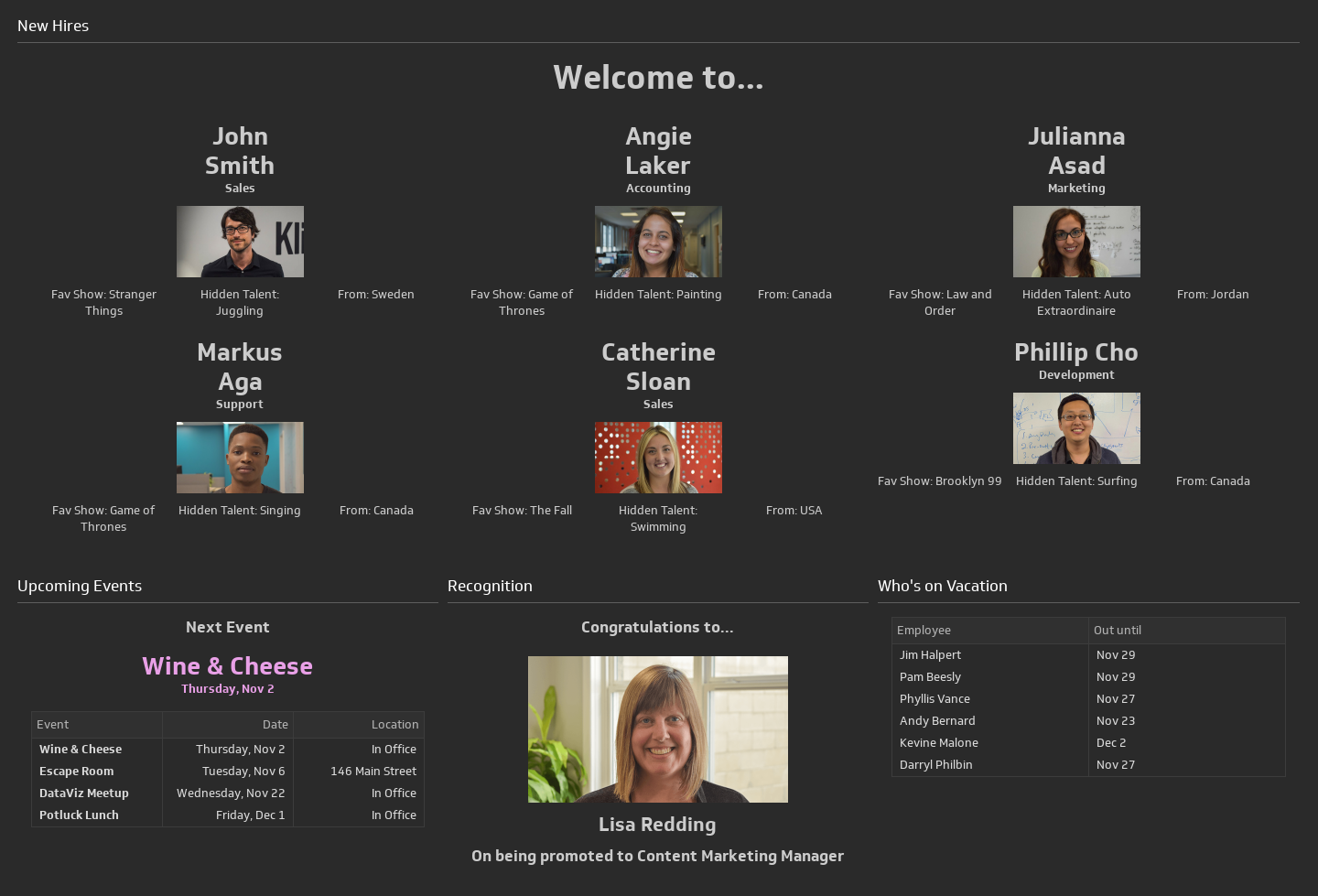
Dashboards can do more than just check in on key metrics. They also have an important role to play in employee engagement and communication.
Creating a wallboard and placing it on a TV in a common area, such as a lunch room or common area, can go a long way to achieving these goals.
A wallboard can help keep employees informed about:
- Who is a new employee
- Who is on vacation
- Upcoming events and holiday calendar
- Rewards and recognition
HR Employee Stats
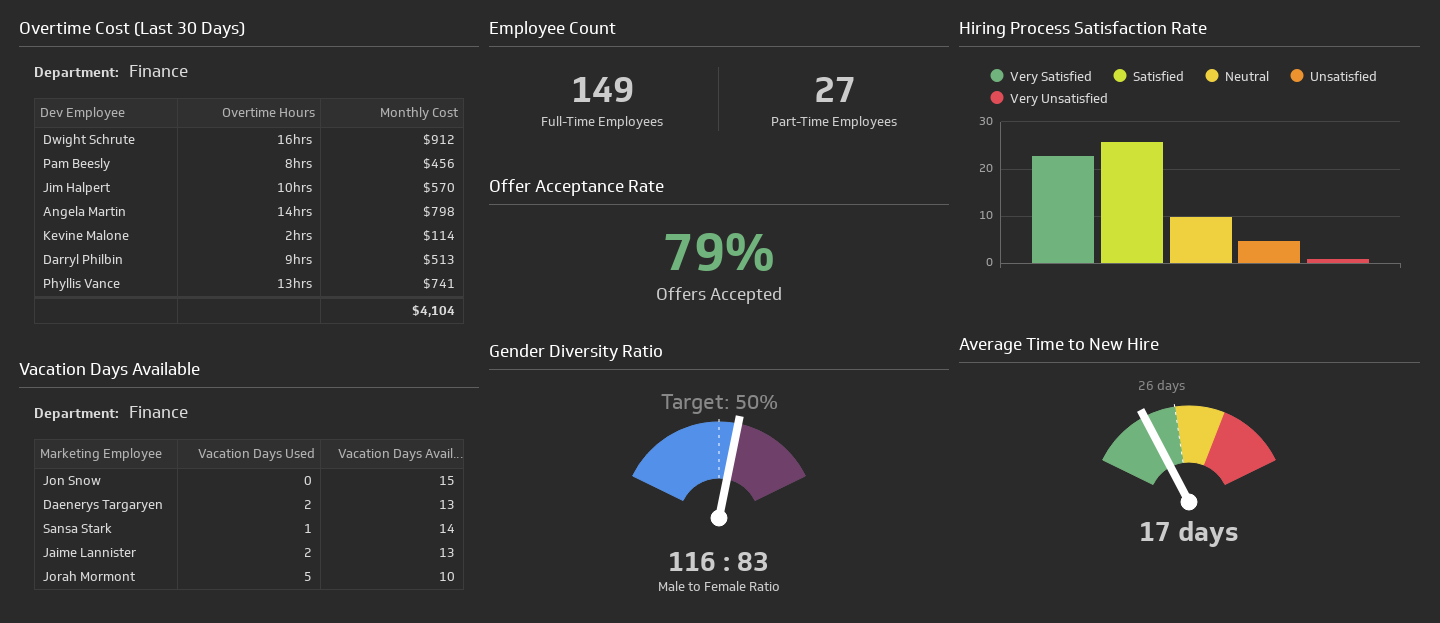
Looking to drill deeper into your current employee base? This board will give you the ability to identify areas where you’ll need to add more employees and plan for the future.
Employment
These metrics will help you identify potential gaps in manpower you’ll need to fill.
- Number of full-time employees: How many full-time equivalent employees you have
- Number of part-time employees: The number of people you employ on a part-time basis
- Number of contractors: The number of people who do work for your company on a contract basis
- Average tenure: The average rate at which employees stay with the company
- Voluntary termination rate vs involuntary termination rate: Gives you an idea of the number of people who leave of their own accord
- First year voluntary termination rate: Gives you a sense for how employees are adjusting after getting hired. A high voluntary termination rate in the first year of employment suggests you need to alter your onboarding policies
- Hiring process satisfaction rate: Usually based on your surveys, this allows you to assess how successful your recruiters are at satisfying potential new employees
- Diversity rate (male to female): Does your workforce skew more male or female?
Hiring
The hiring process is an essential part of recruiting and retaining top talent. These metrics will help you focus in specifically on how potential employees are engaged with the company.
- Average time to find a new hire: Lets you know if you need to speed up (or maybe slow down) your hiring practices
- Number of candidates interviewed per hire: Not finding quality candidates? Maybe you need to start bringing in more people for interviews
- Acceptance rate of new hires: If candidates are turning down job offers, you need to know about it. This suggests you may need to look further at whether the salaries you’re offering are competitive or other factors, such as the interview process
- Rate of internal job hires: Shows you how many people are being recruited to positions from inside the company. While internal hires have their advantages, a high number means you’re not bringing in too many people with fresh perspectives
- Number of referrals from internally: One of the best sources for ideas on new talent is your own team. If people are choosing not to recruit others to the company, it’s also a sign you may need to look at other employee satisfaction metrics
Vacation
HR is about more than just recruitment. You also need to consider how you are allocating your current workforce across the company.
- Number of days outstanding/utilized: A high number of vacation days that are yet to be utilized shows you will need to plan for some absences around the office. Depending on your contractual arrangements with employees, it also could signify a financial liability should you need to pay departing employees for unused vacation.
Employee Leave/Absenteeism
Are your employees missing a high number of work days? There’s only one way to find out. These metrics will give you a sense for whether your workforce is taking a lot of sick days – or maybe coming into work even when they’re sick – as well as other reasons for missing work.
- Number of certified illness/uncertified illness/maternity/jury duty days utilised: Breaks down why your employees are missing work. Useful for planning and allocating resources
Overtime
Overtime can get costly in a hurry. Figure out which parts of the company are utilizing lots of overtime so you budget accordingly and even look at hiring new employees where necessary.
- Overtime: Monthly costs for each department
HR Compensation Tracking
Employees are one of the largest (if not the largest) expenses a company needs to cover. Track how much you’re spending on your workforce with these key metrics.
Cost of Employee Benefits
Employees don’t just earn their salary – in many cases they also receive benefits that come out of the company’s budget. These metrics allow you to keep track of your spending on employee benefits.
- Cost of employee benefits: Salary, health insurance, pension, employee savings plans etc.
Stock Plan Involvement
This is particularly important for start-ups, which frequently offer stock option plans for employees.
- Stock Plan Involvement: Percent of employees participating in stock plan
HR Performance Issues

Some matters – such as legal and disciplinary matters – can explode into big problems if you don’t keep an eye on them.
Legal Issues
Legal matters require close attention. Keep track of all pending and current legal issues your company is facing.
- Legal Issues: Brief overview and status of each case
Disciplinary Issues
Matters of employee discipline can be unpleasant, but if you don’t deal with them in a timely and direct manner you risk making them worse. This will help you keep track of disciplinary issues at each stage of their existence.
- Disciplinary Issuess: Brief description of outstanding disciplinary matters
HR Leadership and Performance Development
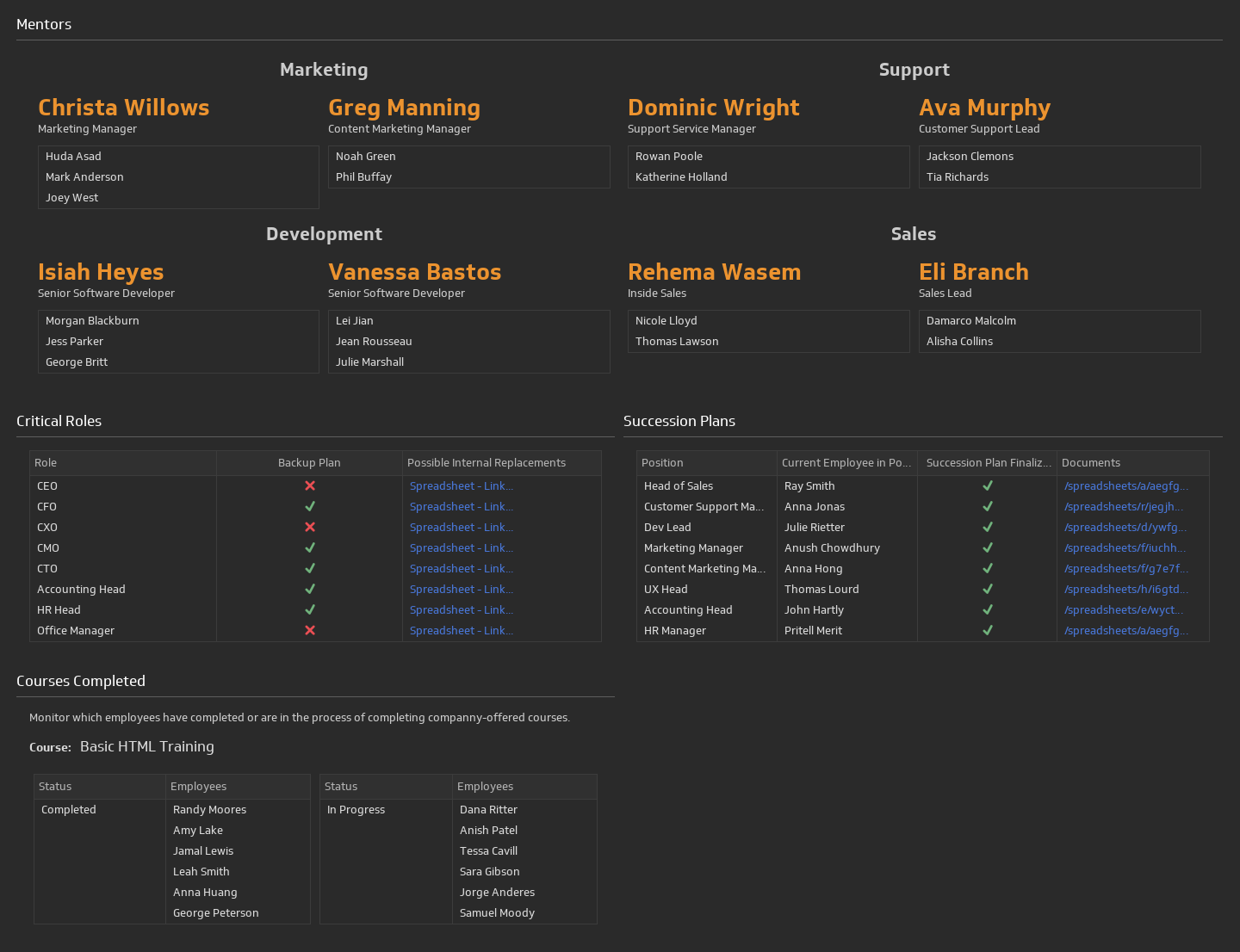
Nurturing nascent leadership candidates and keeping employees at the top of their fields are essential for ensuring the success of your company into the future. Keep track of their progress with these metrics.
Performance Management
This will help you stay on top of HR’s role in evaluating employees’ performance.
- Number of employees who have completed their required bi-annual performance management report
- HR to FTE ratio: Helps you ensure that the HR department isn’t getting any smaller or bigger than it needs to be
Succession Planning
How equipped is your company to survive a termination, retirement or voluntary departure? Stay in the loop with these key metrics.
- Per cent of employees successfully moving up in the organization: Employees showing a willingness to be promoted and take on new responsibilities is important to the future of your company. It also acts a litmus test for employee engagement, as disengaged employees aren’t likely to show much inclination to move up
- Number of succession plans in place: Don’t get caught without a plan in the event of an unexpected departure
- Identification of critical roles with backup plans: Ensure you know in advance who you can’t afford to lose
Talent Leadership Tracking
Employees with leadership potential need to be identified and then coached.
- Individuals identified and then paired with a mentor with whom they meet monthly for coaching
Training
Training your employees is essential. Without an investment in employee development, you’ll quickly find your company falling behind its competitors.
- Courses offered and/or completed: Gives you an idea of how many employees are putting the effort into training and how many are following through on them
- Percentage of employees trained in company culture: If employees aren’t completing company culture training, it could be an early-warning sign of issues with employee engagement
Similar to many of your team members in the finance department, you are most likely pulling some of this data from a variety of sources. At Klipfolio we see data coming from all kinds of sources – some data in an HR tool, some data in spreadsheets, and some in a corporate data warehouse.
That’s where Klipfolio can help. We can pull all your data into one place to help present it to your board, your exec team and your HR team to help really drive home how your department is performing.
Your organization is unique, so the KPIs your organization wants to track will be as well. Focus on the key stories you want to share with your direct HR team, the leadership team and the entire organization. Each of these different segments will want to see insights from you that will help them more easily understand the key value the HR team brings to the organization.
Resources for HR professionals
As a human resource professional, you understand the importance of being data driven and keeping up-to-date on all the latest industry changes. Here are some resources to keep improving your talent management skills:
